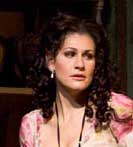Key Word Search
Multi-Field Search
Browse
Repertory Report
Performers Report
Contacts
Met Opera Website
La Traviata
Metropolitan Opera House, Mon, October 20, 2008
Broadcast
Debut : Paolo Carignani
La Traviata (944)
Giuseppe Verdi | Francesco Maria Piave
- Violetta
- Anja Harteros
- Alfredo
- Massimo Giordano
- Germont
- Andrzej Dobber
- Flora
- Theodora Hanslowe
- Gastone
- Eduardo Valdes
- Baron Douphol
- John Hancock
- Marquis D'Obigny
- Louis Otey
- Dr. Grenvil
- Paul Plishka
- Annina
- Kathryn Day
- Giuseppe
- Craig Montgomery
- Messenger
- Joseph Turi
- Dance
- Sara Erde
- Dance
- Christine McMillan
- Dance
- Griff Braun
- Conductor
- Paolo Carignani [Debut]
- Production
- Franco Zeffirelli
- Costume Designer
- Raimonda Gaetani
- Lighting Designer
- Duane Schuler
- Choreographer
- Maria Benitez
- Stage Director
- Kristine McIntyre
La Traviata received nine performances this season.
Broadcast live on Sirius Metropolitan Opera Radio
Production photos of La Traviata by Marty Sohl/Metropolitan Opera.
FUNDING:
Revival a gift of The Sybil B. Harrington Fund
Review 1:
Review of David J. Baker in the January 2009 issue of Opera News
A new conductor and cast gave Verdi's "La Traviata" a hearty welcome when the Met revived its frilly Zeffirelli production on October 20. Things revolved, as is only right, around the intense and sensitive Violetta of Anja Harteros, the German soprano previously heard here as a singer of Mozart.
The soprano's classical credentials were confirmed by her musicianly yet incisive treatment of Verdi's lines, especially the silky, plaintive passages of the later acts - a delicately tinted mezza voce in "Ah! Dite alla giovine," or her wrenching, eloquent "Addio del passato," to cite two pinnacles. Harteros spins ravishing sounds and has that special gift of endowing a pianissimo with delicacy and intensity at once.
Other challenges in the score are more problematic, since the soprano seems most secure in the middle to upper-middle range (up to A) and at medium to low volume. In the higher reaches of "Sempre libera" and its preceding cadenza, the tone lost focus, spreading and darkening in a somewhat lunging attack. But thanks in part to her dramatic demeanor, this reckless, edgy vocal quality also carried expressive force. The desperation so palpable in the final stretto, "Gran Din morir si giovine," sustained Verdi's drama to the end, and the soprano acted and looked the part convincingly through each of the heroine's crises.
Since this opera stands at the crossroads between bel canto form (in Act I) and a more elastic expressive style, conductors sometimes emphasize that progression, especially by starkly contrasting the preludes to Acts I and III. In his company debut, Paolo Carignani did not overload these instrumental passages, which remained wistful rather than searing.
He shaped the performance well, with especially expressive rubato in the Violetta-Germont encounter and the ensuing mournful clarinet solo. I missed that kind of attention in the big ensemble that closed Act II, where Violetta's arching lines can achieve more pathos. Alfredo's rough outburst reached full throttle, however, with an unusually energetic tempo. Nearly always, one could sense the conductor's close interaction with his singers.
Massimo Giordano, the youthful hero, and baritone Andrzej Dobber, as his sourpuss of a father, entered fully into the dramatic spirit, each making his well-turned phrases count. After initial unsteadiness, Dobber gradually asserted himself, with firm, ringing high notes for his aria. Giordano's covered tone deprived the lesser-known cabaletta to "De' miei bollenti spiriti" of its expected impact, but he produced elegant legatos and had heft in reserve when needed. Theodora Hanslowe was the sonorous, sympathetic Flora.
Search by season: 2008-09
Search by title: La Traviata,
Met careers
- Paolo Carignani [Conductor]
- Anja Harteros [Violetta]
- Massimo Giordano [Alfredo]
- Andrzej Dobber [Germont]
- Theodora Hanslowe [Flora]
- Eduardo Valdes [Gastone]
- John Hancock [Baron Douphol]
- Louis Otey [Marquis D'Obigny]
- Paul Plishka [Dr. Grenvil]
- Kathryn Day [Annina]
- Craig Montgomery [Giuseppe]
- Joseph Turi [Messenger]
- Sara Erde [Dance]
- Christine McMillan [Dance]
- Griff Braun [Dance]
- Franco Zeffirelli [Production]
- Kristine McIntyre [Stage Director]
- Maria Benitez [Choreographer]
- Raimonda Gaetani [Costume Designer]
- Duane Schuler [Lighting Designer]
